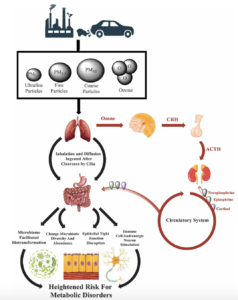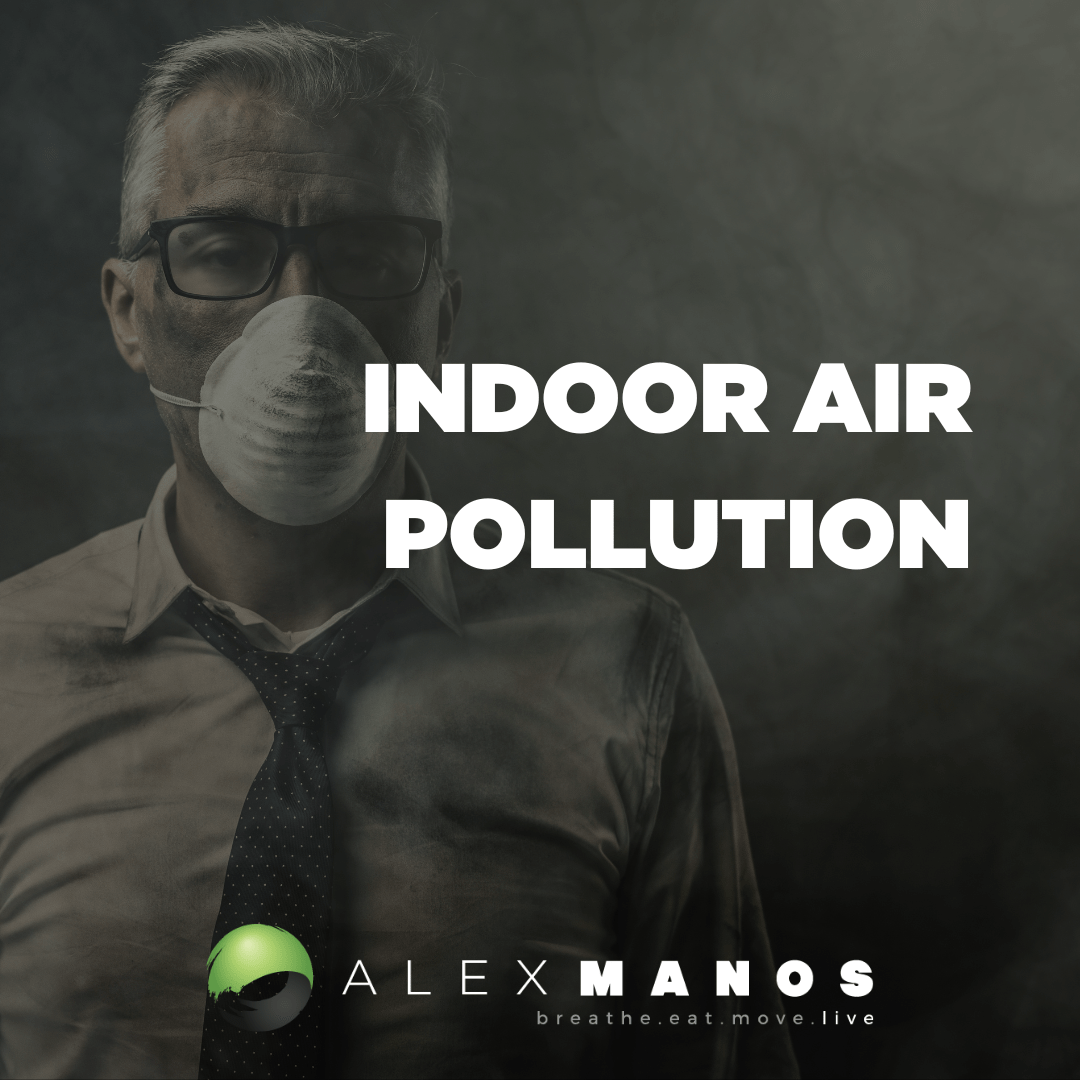Welcome to my blog entitled ‘Indoor Air Pollution: The Silent Problem’.
Before we start, other blogs that you might be interested in, include:
- Can mould and mycotoxins cause multiple sclerosis?
- All my blogs on mycotoxins: click here.
In the UK, poor air quality is a severe environmental risk to public health, with air pollution responsible for 40,000 early deaths. It is estimated to cost £20 billion a year to health services and businesses.
Children growing up in the UK today represent an ‘indoor child generation’, with most of their activities taking place primarily in homes and schools, with chemically diverse environments. Despite its importance in human exposure terms, links between indoor air quality and public health is an under-researched area, with greater emphasis placed on outdoor air quality.
Indoor air pollution is dust, dirt, or gases in the air inside buildings such as your home or workplace that could be harmful to breathe in. Poor indoor air quality has been linked to lung diseases like asthma, COPD and lung cancer. It has also been linked to increased risk of heart disease and stroke.
Types of air pollution include:
- particulate matter (pm) – tiny particles of dust and dirt in the air, such as soot and dust mites
- Gases – for example carbon monoxide, nitrogen oxide, and sulphur dioxide
Indoor air pollution can be caused by anything from gas stoves and wood burners, to damp and mould.
Who can be affected by poor indoor air quality?
The British Lung Foundation explain how “anyone can be affected by indoor air pollution. If you live with a lung condition, such as COPD, asthma, or bronchiectasis, you’re more likely to be affected by poor air quality as your lungs are more sensitive – although not everyone has the same reactions to the dust, dirt and gases in our homes.
If you have a severe lung condition you might find it harder to move around, so may spend more time indoors. This means you may have more contact with things that affect the air you breathe indoors. These could include cigarette smoke, cleaning products or mould.
Children are particularly vulnerable to poor indoor air quality as their lungs are still developing. Children’s airways are smaller, so inflammation caused by indoor and outdoor air pollution can cause them to narrow more easily than in older people.”
How can I improve the air quality in my home?
- Keep rooms well aired.
- Use allergy friendly or chemical-free products.
- Use solid or liquid cleaning products: Unlike sprays, these won’t get into the air for you to breathe in.
- Prevent condensation.
- Fix any leaks or water damage – quickly!
- Keep your home smoke-free.
- Use electric or gas heating.
- Vacuum regularly
- Get a good air purifier. I use an air doctor.
- Consider having air purifying plants around the house.
What Causes Indoor Air Pollution?
- Heating and cooking at home
- Damp and mould
- Smoke and vapour
- Chemicals we use for cleaning and decorating
- Building materials
Harmful pollutants inside buildings include carbon monoxide (CO), volatile organic compounds (VOCs), particulate matter (PM), aerosol, biological pollutants, and others (1).
These two lists come from the British Lung Foundation.
What Is Sick Building Syndrome?
Sick building syndrome often refers to a group of symptoms that are linked to the physical environments of specific buildings. Acute health and comfort effects of SBS will appear when patients spend a certain amount or duration of time in a building, but they and their causes are difficult to clearly identify. These effects are either localized in particular areas or widespread throughout a building. It has been reported that symptoms tend to worsen as a function of the exposure time in buildings and can disappear as people spend more time away from the building.
According to the WHO, SBS symptoms caused by IAP can be divided into four categories (1):
- Mucous-membrane irritation: Eye, throat, and nose irritation.
- Neurotoxic effects: Headaches, irritability, and fatigue.
- Asthma and asthma-like symptoms: Chest tightness and wheezing.
- Skin irritation and dryness, gastrointestinal problems (i.e., diarrhea), and others.
The International Labour Organization (ILO) reported that infants, the elderly, persons with chronic disease, and most urban dwellers of any age have higher health risks linked with IAP-associated SBS symptoms. A low ventilation rate, building dampness, and high room temperature also tend to increase the likelihood of SBS prevalence. Moreover, other risk factors, such as gender, atopy, and psychosocial factors, also have a significant influence on SBS symptom prevalence (1).
What Is Building-Related Illness (BRI)
BRI describes illnesses and symptoms with an identified causative agent directly related to exposure to poor air quality in buildings. It is known that causative agents can be chemicals, such as formaldehyde, xylene, pesticides, and benzene, but biological agents are more widespread. In buildings, the typical sources for indoor emissions of biological contaminants are cooling towers, humidification systems, filters, drain pans, wet surfaces, and water-damaged building material.. BRI symptoms have been associated with the flu, including fever, chills, chest tightness, muscle aches, and cough. In addition, serious lung and respiratory problems are likely to occur. (1)
Common BRI illnesses include Legionnaires’ disease, hypersensitivity pneumonitis, and humidifier fever. It was reported that indoor environmental pollutants can cause BRI symptoms via four major mechanisms (1):
- Immunologic.
- Infectious.
- Toxic
- Irritant.
An irritant effect is often BRI’s initial insult, but toxic, allergic, or infectious mechanisms can arise subsequently, depending on the pollutant type and individual susceptibility. Psychologic mechanisms are often not paid significant attention but are demonstrably likely to increase the overall morbidity of building-related diseases as well.
Four main factors have been linked to BRI, including (1):
- Physical-environmental factors,.
- Chemical factors,.
- Biological factors.
- Psychosocial factors.
As for the physical-environmental factors, BRI can be influenced by the temperature, humidity, lighting, air movement, and dust concentration. The chemical factors, meanwhile, include various pollutants released from human activities and products, such as carpets, paint, new furniture, smoking, cosmetics, asbestos, drapes, and insecticides. Finally, major biological factors associated with BRI are microorganisms (1).
My Interview With Rensair – Specialists In Air Purification
Indoor Air Pollution And Gut Health
Work has shown that increased exposure to air pollutants independently contributes to obesity and type 2 diabetes risk, and while the exact mechanisms underlying these associations are not fully understood, recent research (1) discusses the findings regarding the impact of inhaled and ingested air pollutants on the gut microbiome.
Animal and human studies provide evidence that air pollutants, such as particulate matter, nitrogen oxides, and ozone, have the potential to alter the gut microbiome. Further, studies suggest that such exposure-induced alterations to the gut microbiome may contribute to increased risk for obesity and type 2 diabetes through inflammatory pathways.
Therefore, exposure to air pollutants may contribute to increased risk for obesity and type 2 diabetes through alterations to gut microbial composition and function.
For example, several studies have found associations between elevated levels of air pollution exposure and gastrointestinal diseases, including inflammatory bowel disease (IBD), irritable bowel syndrome, appendicitis, and gastroenteric disorders in infants. Cigarette smoke, which contains particulates that are present in ambient and traffic-related air pollution, has also been shown to alter the composition of the gut microbiota.
Studies have provided preliminary evidence that exposure to airborne particles may alter the gut microbiota and gut health
How Does Air Pollution Affect The Gut?
It has been proposed that air pollution can affect the digestive system due to:
- The pro- and anti-bacterial effects of particle matter such as black carbon and toxic metals such as lead.
- Biofilm formation.
- Ozone induced activation of the HPA axis.
The GI tract is exposed to large amounts of particle matter, which has the potential to exert pro- and anti-bacterial effects on gut bacteria that may alter gut physiology, including immune responses, metabolism, and intestinal permeability (aka leaky gut).
For example, studies suggest that components of air pollution, such as elemental carbon, black carbon, nitrates, sulfates, and toxic metals like lead and arsenic may alter host bacterial communities through antimicrobial properties and the formation of biofilms.

Ozone induced activation of the HPA axis may increase the production of cortisol and norepinephrine, which may alter the composition of the gut microbiota.
Stress hormones such as noradrenaline may also induce changes in the enteric nervous system, which can alter gastrointestinal motility, mucus secretion, and ion transport. Such changes in the gut environment could lead to alterations in the gut microbiome.
Overall, this hypothesised mechanism is supported by the gut-brain axis, which allows for bidirectional communication that may result in changes in bacterial proliferation in the presence of noradrenaline at the gut.
It is suggested that the requirement for microbial input from the environment to drive immunoregulation is a major component of the beneficial effect of green space, and a neglected ecosystem service that is essential for our well-being (11).
Conclusion
In conclusion, pollutants in the indoor air environment are significant contributing causes of human diseases. There are numerous indoor air pollutants, including PM, VOCs, CO, CO2, ozone, radon, heavy metals, aerosols, pesticides, biological allergens, and microorganisms, all of which can lead to diminished IAQ and thereby harmful effects on human health. Most of these pollutants usually originate from two main sources (1):
- Human activities in buildings, such as combustion, cleaning, use of certain building materials in the course of construction or renovation, and operation of electronic machines.
- Transportation from outdoor sources.
Although these pollutants are often present at only low concentrations in buildings, long-term exposure can cause significant risks to human health. Generally, there are two categories of building-associated illness: Sick building syndrome (SBS) and building-related illness (BRI) (1).
References
- Indoor Air Pollution, Related Human Diseases, and Recent Trends in the Control and Improvement of Indoor Air Quality: click here.
Alex is a certified Functional Medicine Practitioner (IFMCP) and has a MSc in Personalised Nutrition. He is also a breathwork facilitator with a background in personal training and massage therapy. He also runs The Resiliency Program - a 24 week program aimed at building physical, mental, emotional, and spiritual resilience.



